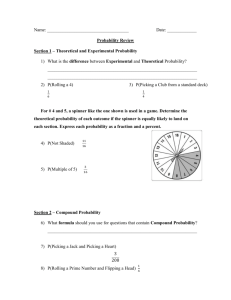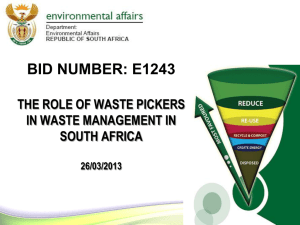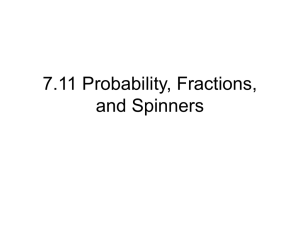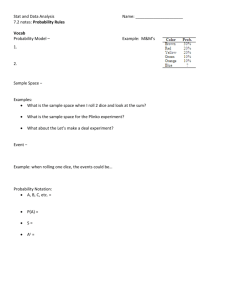Waste picking & livelihoods in Grahamstown
advertisement
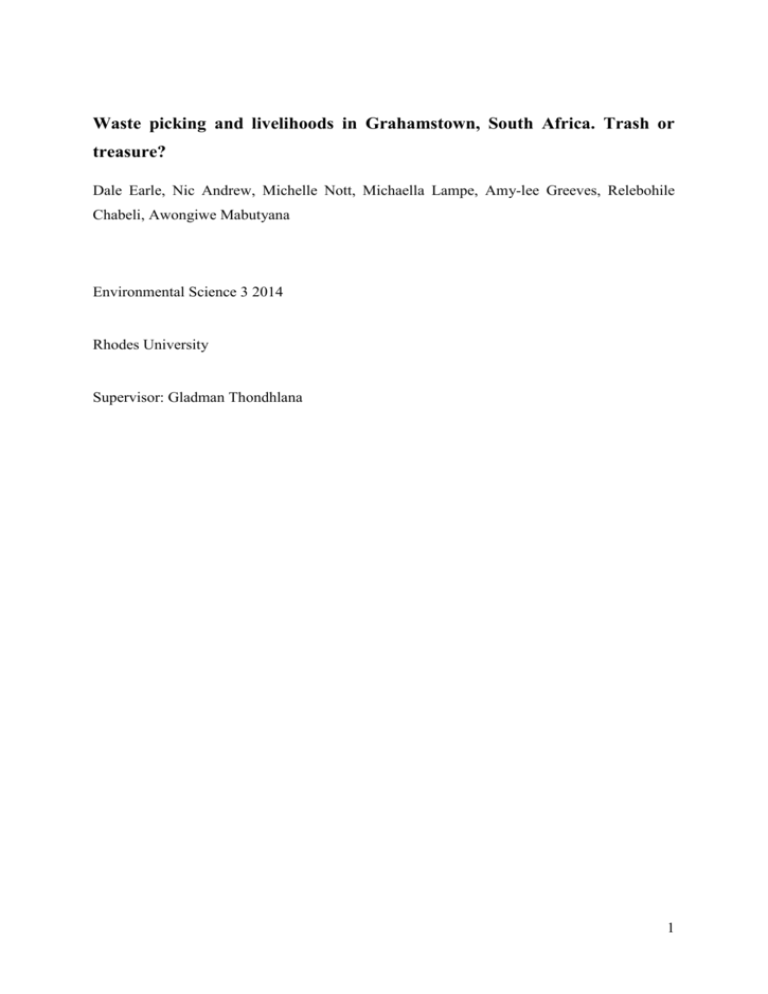
Waste picking and livelihoods in Grahamstown, South Africa. Trash or treasure? Dale Earle, Nic Andrew, Michelle Nott, Michaella Lampe, Amy-lee Greeves, Relebohile Chabeli, Awongiwe Mabutyana Environmental Science 3 2014 Rhodes University Supervisor: Gladman Thondhlana 1 Contents 1. Introduction ........................................................................................................................ 5 2. The case study town, Grahamstown ................................................................................... 7 3. Methods .............................................................................................................................. 8 3.1 Data collection ................................................................................................................. 8 3.2 Data analysis ................................................................................................................. 10 4. Results and discussion ...................................................................................................... 11 4.1 Socio-economic characteristics of the respondents and households ............................. 11 4.2 Waste collection and contribution to household income ............................................... 11 4.3 Key sources of waste picking income (all types of all material collected) .................... 13 4.5 Determinants of waste picking income .......................................................................... 15 4.6 Waste pickers’ perceptions on challenges encountered ................................................ 17 5. Recommendations and conclusion ................................................................................... 17 References ................................................................................................................................ 18 2 List of figures Figure 1: Map of Grahamstown……………………………………………………………. .8 Figure 2: Average difference in Total Annual Income with and without Waste Picking Income ………………………………………………………………………………………Err or! Bookmark not defined.2 Figure 3: Recyclable materials collected and sold by waste pickers………………………. Error! Bookmark not defined.3 List of tables Table 1: Poverty incidence and poverty gap with and without waste picking income…….145 Table 2: Multiple linear regression analysis……………………………………………….Error! Bookmark not defined.6 3 Abstract This study examines the contribution of waste picking to the livelihoods of waste pickers in a medium sized-town of Grahamstown, South Africa. We collected data through a structured survey of 60 waste pickers and their households. Most households are poor, living on less than UDS1 a day. Waste picking contributes about 70 % of total household income. An analysis of household income with and without waste picking income using the food poverty line showed that waste picking reduced poverty incidence and poverty gap by 29 % and 68 % respectively. Household size, gender, frequency of waste collection, access to transport and poverty status were the major determinants of waste picking income. The findings highlight the importance of waste picking income to the livelihoods of the urban poor, and the need to acknowledge and support waste picking as a potential poverty alleviation strategy in medium sized towns of South Africa, where job opportunities are often limited. Key words: Waste picking, livelihoods, urban poor, poverty 4 1. Introduction Globally, the contribution of waste picking on the livelihoods of waste pickers’ is being increasingly explored, particularly in developing countries. Empirical evidence increasingly shows that waste picking is a key source of livelihood improvement for many poor urban dwellers (Njoroge et al., 2013). In India for example, studies have found that many women, often positioned in the lower echelons of poverty, have no choice but collect waste as an income generating activity (Huysman, 1994). According to Huysman (1994), there are limited opportunities for such women in the labour market due to their economic and social status and are therefore forced to take on informal and underestimated jobs such as waste picking. In Duoala, Cameroon, waste picking has been shown to reduce poverty among the poor waste pickers (Mbeng, 2013). In a study of waste picking in the United States, Mamphitha (2011), found that the mean monthly income of a waste picker was $41.28 (± R454.08). Often waste pickers choose what they collect in terms of what they can sell and use the most (Schneck and Blaauw, 2011). Waste pickers are the initial link in the recycling sequence and form the base in the hierarchy of waste management (Nzeadibe et al., 2012). It is also argued that waste collection activities while providing an income to the urban poor, indirectly contributes to recycling in cities. A South African recycling company, PETCO, reported that 23,000 tonnes of PET such as milk bottles were collected in 2008 (Mamphitha, 2011) contributing to mitigating the effects of climate change by reducing greenhouse gas emissions through the recycling of waste (SEWA, 2009). Despite the potential benefits of waste picking to the urban poor and overburdened waste management services, waste pickers’ are faced with various challenges ranging from social exclusion, health risks and well-being to unfair market prices. For example, there are some negative connotations attached to waste pickers as waste picking is often conceived to be a symbol of poverty (Medina, 2007). It is also not uncommon to find waste pickers working without proper protective equipment – which endangers their health and well-being. Nzeadibe et al. (2012) revealed that 81.5% of waste pickers were confident that the health-related challenges they faced were not associated with their job. With regards to unfair market prices, 5 waste picking forms part of a complex waste hierarchy and waste pickers’ usually lie at the bottom of that hierarchy, while merchants or recycling companies disproportionately benefit from the exchange money or goods for recyclable materials brought in by waste pickers’. Often what waste pickers’ get paid is largely determined by the merchant and some merchants exploit waste pickers’ by paying them the bare minimum for waste materials (Schenck and Blaauw, 2011). Further, different waste types also fetch various returns and therefore waste pickers often experienced fluctuations regarding their income (Mamphitha, 2011). According to Sapuay (n.d.) lack of safety, adverse working conditions and low incomes are indicative of the fact that waste pickers are often poor and desperate urban dwellers who collect waste for basic survival. Due to poor recognition of the waste income sector, waste picking is often ignored and very little effort is made to support waste picking activities (Wilson et al., 2006). As urban populations continue to grow faster, the majority of urban migrants are moving to smaller and medium sized towns of less than 500 000 inhabitants (UN HABITAT, 2006; World Bank, 2009), as they seek employment opportunities (Montgomery, 2008). The effects of urbanisation are more immediate and noticeable in relatively small and medium sized towns (Drakakis-Smith, 1995). However, most studies on the contribution of waste picking have been done in large cities (e.g. New Delhi and Bangalore in India, Durban in South Africa). In South Africa, medium sized towns have seen the influx of people from nearby rural areas as rural dwellers seek for employment opportunities. Thus, waste picking can be seen as a potential source of livelihood especially as unemployment levels remain very high. However, despite the continued recognition of waste picking to the livelihoods of the urban poor world-wide, there is a still limited empirical evidence on the value of waste picking and the challenges faced by waste pickers’ in South African medium-sized towns. Further, while a lot has been written on the contribution of waste picking to the urban poor, comparatively few studies have explored the waste picking-poverty links. Omission of income from waste picking in urban-based poverty assessments may result in underestimation of the urban poor’s income, non-recognition of the waste picking sector and subsequently, adoption of poorly informed poverty alleviation and waste management interventions. Therefore, to get the ‘bigger picture’ on waste picking and livelihoods, there is a need for studies in medium-sized towns and examining waste picking and its influence on poverty reduction. Empirical evidence could be used to better inform various waste management 6 options and leverage some responsiveness from interested stakeholders such as government and NGOs on the plight of waste pickers’ and acknowledgement of waste picking as a cost effective way for managing waste. In light of this background, this research has four main objectives. First, the paper aims to enhance understanding on the contribution of waste picking to the livelihoods of waste pickers’ and impact on poverty alleviation using a medium smallsized South African town as a case study. Second, the study explores the socio-economic factors that influence waste picking income. Third, we document waste pickers’ perspectives on the challenges they face in waste picking activities. Fourth, we discuss the implications of the findings on waste picking debates and on a more practical level, what this means for waste management practices in Makana Municipality. We hypothesise that waste picking is a significant contributor to the urban poor’s livelihoods. 2. The case study town, Grahamstown Grahamstown is a medium-sized town located in the Eastern Cape Province of South Africa (33◦ 31’ S, 26◦ 53’). The temperature in Grahamstown ranges from -4°C to 42°C and the mean annual precipitation is 550 mm (Etengeneng, 2012). The town is administered by the Makana Municipality. Grahamstown, similar to other South African towns, has a sizeable proportion of poor urban people as evidenced by a high dependence on government social grants. The settlements in Grahamstown consist of 27 built-up residential areas and Rhodes University (Etengeneng, 2012). According to Davenport et al. (2012) the township is home to 9120 households which accommodate the majority of the people living in Grahamstown. Based on an estimate from 2003, the population was greater than 124 000 (Etengeneng, 2012) and continues to escalate (Davenport et al., 2012; Adama, 2014). The major formal employers in Grahamstown are the military, primary and high schools, Rhodes University and other service related industries such as retail shops and financial institutions. Most people are also employed in the informal sector including hairdressing, housekeeping and street vendoring among others. 7 Figure 1: Location of Grahamstown Like many authorities in developing countries’, cities and towns (Montgomery, 2008), the local Makana Municipality of Grahamstown face many service delivery challenges primarily due to growing urban populations. Some of these challenges include providing work opportunities to the growing number of urban poor who often have lower education levels to get into mainstream formal jobs (Gwedla and Shackleton, 2014) and waste management given high production of waste (Montgomery, 2008). 3. Methods 3.1 Data collection Data was collected between April and July 2014 using structured questionnaires with open and closed ended questions. The questionnaire was designed to capture socio-demographic information and all the income sources of the respondents and their households. The section on waste picking activities collected information on all the different types of material that was collected, frequency of collection, what they actually did with the collected material, how collected materials were transported, the reported incomes generated from commercialisation, circumstances leading to waste picking activities and waste pickers’ perspectives on the challenges they faced. 8 We attempted to approach all waste pickers at the main Grahamstown waste dump and along the streets for the surveys. A total of 60 waste pickers participated in the surveys – with a fair presentation of dump and street waste pickers. We stopped the surveys when we realised we were encountering previously interviewed respondents. We collected data after informing the participants about the intention and purposes of the study. We also highlighted that participation was completely voluntary though some respondents asked for incentives. Further, we made assurances of participants’ anonymity and confidentiality of their responses. This study considers waste as discarded materials which are of no use any more to the previous owner and, waste pickers’ as individuals who collect discarded materials from streets, outside houses and/or businesses for income and survival, following Pongrácz and Pohjola (2004). 9 3.2 Data analysis We generated income accounts to estimate the contribution of waste picking income to the respondents’ household income portfolios. We estimated waste income as reported income per day x frequency of collection per week x 52 weeks per week. In our calculation of waste picking income, the opportunity costs of labour were not considered because according to Gram (2001), deducting these in situations of low earning skills and negligible labour opportunities can be misleading. All the reported waste income values in this study were estimated at a gross income basis. During the data collection period, the average exchange rate between the South African Rand (ZAR) and the U.S. Dollar was roughly U.S. $1.00 = ZAR10.5. We used a headcount index and poverty gap index to measure the proportion of poor households (poverty incidence) and the depth of poverty with and without waste picking income respectively. The poverty gap index measures the extent to which households or individuals on average fall below the poverty line, and expresses it as a percentage of the poverty line. We calculated the poverty gap index as the poverty gap (Gi) [poverty line (z) less average actual income (yi) for individuals], expressed as a percentage of the poverty line (z). According to Leibbrandt et al. (2010), the poverty gap index puts more emphasis on the poorest of the poor. We used both household income and per capita income as the income measure, for easy comparisons across the datasets available. While there is a plethora of poverty measures in the poverty literature, we used a 2011 food poverty line of ZAR3 852 (US$367) per capita per year (or ZAR321 (US$31) per month) (Statistics South Africa, 2014). Our choice of the food poverty line is based on the fact that one of the many challenges facing the urban poor is food insecurity (UN- HABITAT, 2006). We used a simple multiple regression analysis to estimate the effect of various socio-economic factors on waste picking income. The choice of our explanatory variables (standard income, age, gender and education of respondent, frequency of collection, poverty status, and method of waste transportation) were based on economic theory and common sense. For example, we hypothesised that as income from other sources increases, dependence on waste picking income would decrease since households will have other buffers to fall on in times of shocks. With regards to age, we expected that as age increased, waste income was likely to decline as energy levels to collect declines with aging. We expected a positive relationship between access to 10 transport (e.g. cars) and waste income because access to transport can increase the amount of waste collected. A high frequency of waste picking was obviously expected to result in more waste income. Further, given that most of the respondents lived below the poverty line, we used a poverty status dummy to determine its influence on waste picking income. 4. Results and discussion 4.1 Socio-economic characteristics of the respondents and households Out of all the respondents surveyed 78 % were males. The average age of all the respondents was 39 (±16.46) years. The 20-29 years age group was the dominant one, constituting 34 % of all the respondents. The average years spent at school were 6.5 (±3.59). Out of all the respondents, 66 % did not have a secondary education – perhaps explaining why most respondents (97 %) did not have jobs. Moreover, Nzeadibe et al. (2012) found that 77 % of waste pickers would prefer to complete formal education and thus be able to promote livelihood security in their households. If waste pickers have a higher level of education, they may possess skills that could contribute to the betterment of their livelihoods. Most of the respondents (80 %) were single while the remaining were either married or widowed. The average household size was 4 (±2.11) people. Thirty five percent of the respondents received social grants – suggestive of the fact that most of the households are poor (Shackleton et al., 2008). 4.2 Waste collection and contribution to household income On average respondents collected waste 4 (±1.71) days a week ranging from 1-7 days and spent an average of 7 (±3) hours per day ranging from 2-11 hours. Sixty percent of the respondents carried the waste on their heads or backs to the recycling companies whereas the remaining respondents either walked or got lifts to the recycling companies. Most households (61 %) were generally poor living on less than USD1 per day. Waste picking income contributed about 70 % (ZAR 8365.28 or USD 797) of the total annual income per household while the remaining proportion was mainly from government grants. Figure 2 shows the average total household annual incomes with and without waste picking income. The mean total annual income was approximately ZAR13161 (USD1253) and ZAR4796 (USD474) with and without waste picking income respectively. There was a significant difference between total annual income with and without waste picking (t = 3.849; 11 p =0.000). This indicates that waste picking is a substantial contributor to the livelihoods of the urban poor (Langenhoven and Dyssel, 2007). R 4,500.00 R 4,000.00 R 3,851.51 Average annual income (ZAR) R 3,500.00 R 3,000.00 R 2,500.00 R 2,000.00 R 1,500.00 R 1,215.48 R 1,000.00 R 500.00 R 0.00 With waste picking income Without waste picking income Average annual income per capita Figure 2: Mean household annual income with and without waste picking income per capita The findings demonstrate that waste picking is a key livelihood source for the urban poor consistent with findings elsewhere. For example, figure 2 shows that the majority of household income is derived from waste picking (t = 4.883; p = 0.000). In a study on waste picking as a survival strategy for Indian woman, Huysman (1994) found that woman mostly worked in this informal sector for the financial benefits. Waste collection within communities around the world has proved to be a great contribution to the livelihoods of low income communities (Njoroge et al., 2013). According to Wilson et al. (2006), in developing countries, waste picking is often carried out by the poor and marginalised social groups as a source of income and daily survival. Similarly, Nkosi and Muzenda (2013) argue that poverty is the main driver of waste picking in South Africa. 12 4.3 Key sources of waste picking income (all types of all material collected) The reported key sources of waste were plastic, glass, metal, paper, rubber and cardboard. As shown in Figure 3, the most commonly collected and sold material were plastic, glass and metal cited by (52%), (43%) and (38%) of the respondents respectively. Paper, cardboard and rubber were collected the least cited by 18%, 10% and 5%. Each of the waste material was predominantly collected for sale but was also the respondents mentioned using at least on material for household purposes. 60.0 51.7 Proportion (%) of respondents 50.0 43.3 38.3 40.0 30.0 18.3 20.0 10.0 10.0 5.0 0.0 Plastic Glass Paper Metal Cardboard Rubber Type of waste collected Figure 3: The main recyclable materials collected and sold by waste pickers Waste pickers’ preference of certain waste was dependent on what they could sell or use at home consistent with other studies (Schenck and Blaauw, 2011). In this study, waste pickers reported that plastic, glass and metal were waste materials mostly sought after by merchants. These materials were sometimes used at home for domestic purposes – for example empty plastic buckets and bottles are used for water collection and storage and metal as building material. We found that 13 % of waste pickers’ scavenged for food to use at home. This practice is comparable to findings elsewhere. In a study done in Buenos Aires, Argentina, Parizeau (2013) found that 61 % of waste pickers’ scavenged for food to eat. However, the food that the waste pickers’ scavenged on was food that was set aside in separate refuse bags and were not placed with the rest of the waste to avoid waste pickers’ from getting sick. Food that is put in the same bags as other household waste is often a health hazard. In this study, some waste 13 pickers reportedly got sick from drinking milk that was discarded with all household waste. The collection of food is essential to waste pickers’ because they need to survive (OtengAbabio, 2012), however there is need to ensure that such activities do not pose a health risk to waste pickers. 4.4 Waste picking and poverty reduction Table 1 shows the poverty incidence and poverty gap for household members with and without waste picking income, using three poverty lines. Using the food poverty line, the findings show that the proportion of poor people with waste picking income was 61 % but increased by 29 % without waste picking income. Total annual income is reduced by more than three times from ZAR3852 (USD367) to ZAR1215 (USD116) per household per year without waste picking income. Poverty-gap analysis shows that on average no-one lived below the food income poverty line but 68 % of the people would fall below the poverty without waste picking income. Similar analysis using the lower bound poverty line and the upper bound poverty line yielded similar trends. Table 1: Poverty incidence (PI) and poverty gap index (PGI) with and without waste picking income Proportion (%) of Mean annual poverty line (ZAR) PI with waste picking income PI without waste picking income PGI with waste picking income PGI without waste picking income 3852 61 90 0 68 14 people using the food poverty line (R321/month) Proportion (%) of people using the lower bound poverty line (R443/month) Proportion (%) of people using the upper bound poverty line (R620/month) 5316 77 92 28 77 7440 87 97 48 84 The results are suggestive of two aspects. First, waste picking income reduces the number of poor people. Second, waste picking also cushions people from falling deeper into poverty; hence waste picking could be seen as safety net for the urban poor. According to Gonzales (2003), waste picking contributes poverty reduction, which is one of the major problems facing developing countries today. 4.5 Determinants of waste picking income We regressed various respondents and household variables (such as age, gender, education, household size, frequency of waste collection and access to transport) against waste picking income. The results are presented in Table 2. Fifty-six percent of the chosen variables were significantly related to waste picking income. Overall, the regression model shows a significant relationship between the chosen explanatory variables and waste picking income (F = 3.416; p < 0.003). The model explains about 25 % of the variation in waste picking income. Gender of respondent, household size, access to transport, frequency of collection and poverty status were all significantly and positively related to waste picking income. Age and education of respondent, standard income and hours spent in waste collecting activities did not yield any significant relationships. Table 2: Ordinary Least Squares (OLS) regression of waste picking income against socioeconomic variables Variable Expected b* Std. Err. of b* b p-value sign Intercept -13081.8 0.318318 Gender + 0.246462 0.143183 8729.9 0.091258* Age - -0.053818 0.177451 -48.1 0.762909 15 Edu-Grade - -0.15952 0.156184 -642.3 0.311905 H-size + 0.39014 0.12479 2723.5 0.002921** Grant total - -0.070012 0.132582 -0.1 0.599743 Hours + -0.059117 0.149625 -330.7 0.694416 Transport + 0.254392 0.134125 7782.9 0.063541* Frequency + 0.281548 0.135997 2419.7 0.043511* Poverty status + 0.509091 0.120522 15416.1 0.000099*** ***, **, * Represent 1%, 5% and 10% levels of significance respectively. With regards to gender, there was no significant difference in waste picking income between males and females (p> 0.05). The results, though not statistically strong, seem to suggest that men were likely to extract more income from waste-picking activities than females because of the energy and strength required to lift and transport heavy material from the dump and streets to the merchants’ place of business. Household size was significantly and positively related to waste income perhaps due to waste pickers having to support more dependants. Waste pickers with access to transport was more likely to tap more from waste picking activities obviously because they were more likely to transport more waste than those who carried waste on their heads and backs. A higher frequency of waste collection was likely to result in higher income from waste picking because of the likelihood of collecting large quantities of waste. The poverty status dummy shows that poor waste pickers were likely to have more income from waste – perhaps because for most of the poorest of the poor, waste picking is often the only source of livelihood. Results from a study done by Nzeadibe et al. (2012) in Nigeria showed that 80% of waste pickers would stop waste picking if other sources of employment were available. Similar to our findings, these results show that many people engage in waste picking due to the lack of sufficient alternative employment. Households with other sources of income such as grants have other options to fall back on for example part time jobs and remittance. However, as noted above, our regression explains only 25 % of the variation in waste picking income. This seems to suggest that other household factors and those beyond the control of the waste pickers could have an influence on waste picking activities. For example, weather, unsorted waste, protective equipment, as well as the health of the waste pickers themselves and lack of institutional support from the government and other stakeholders may affect the amount of waste collected. 16 4.6 Waste pickers’ perceptions on challenges encountered More than half (62 %) of the waste pickers said they encountered constraints in their waste picking activities. The respondents mentioned cuts on their fingers (due to lack of protective wear) which often led to infections, the bad odour coming from mixed wet degradable and non-degradable waste in refuse bags and at the dumps, ‘bad’ weather and lack of transport as some of the main challenges. Other respondents said they had problems with scavengers (dogs and animals) that ripped apart waste bags before they collected waste. They said that they are often wrongly blamed for littering streets yet it is the scavengers responsible for littering. Some waste pickers’ also said that some residents threatened them and perceived that that dog owners deliberately released their dogs on them similar to findings by Nguyen et al. (2003). When asked what could be done to improve their plight, 76 % cited provision of jobs and the rest proposed transport for moving their waste. The need for jobs highlights that most people in the waste picking do so not by choice but as the last option. It may be that the working conditions are also not good hence waste pickers would opt out of waste picking if better alternatives were offered. We also asked waste pickers’ perceptions on their contribution to local Makana Municipality’s waste management services. More than half 55 % of waste pickers perceived that they were helping the municipality. 5. Recommendations and conclusion Is waste picking trash or treasure? The findings of this study show that waste picking is a key livelihood source for the urban poor. This is because it prevented waste pickers’ from falling deeper into poverty. However, it seems that the potential of waste picking as a poverty reduction strategy could be enhanced if waste picking is formally acknowledged and supported as a viable income generating activity. The general public need to be educated about waste management and awareness needs to be created in the form of workshops, focus groups and programs. Through education, negative perceptions of waste pickers’ will be reduced and the community will be more inclined to be active participants in sorting their own waste. This will contribute to improving the waste pickers’ working conditions and potential income. Waste pickers’ have a positive influence on sustainable waste management which is one of the main problems faced by developing countries (Gonzales, 2003). For example waste pickers’ collect around 50-100% of recyclable material in many developing countries without cost to the 17 municipality (Sharholy et al., 2008). The price of recyclable waste needs to be negotiated among the recycling stores and waste pickers to reduce exploitation and increase their bargaining power. The municipality needs to consider providing protective gear, transport, health care services and compensation for services rendered for the removal of waste (Adama, 2014). Langenhoven and Dyssel (2007), who did a similar study in Durban, found that people within the lower income bracket engaged in waste picking as their way of raising household income. The main challenge is the lack of formal recognition across the waste management hierarchy which creates a platform for exploitation (Adama, 2014). To address this problem waste pickers’ need support from the municipality and interested stakeholders to allow alliances to be formed. For example, Colombia, in South America, has the oldest and most successful waste picking organisation in the world (Medina, 2000; Medina, 2007; Adama, 2014). Through these alliances self-esteem and social status can be enhanced which may give waste pickers a higher bargaining power when dealing with merchants (Adama, 2014). Income of the waste pickers’ may increase which could result in an improved quality of life. Waste pickers’ in South Africa, could gain empowerment through the formation of unions. For example, in South Africa, waste pickers’ from across the country gathered for The First National Waste Picker Meeting in 2009 which shows the potential for waste pickers’ to form alliances (Adama, 2014). This could improve their bargaining power when dealing with merchants and could allow them to compete economically. For example, once unions have been established, waste pickers can start to bid for tenders to collect and sort waste which helps avoid the middle man (the merchant) and improve the market value of waste. This is difficult to achieve without multiple actors involved in the tender acquisition process. Middlemen are able to buy waste materials as they form a connection between waste pickers and the waste industry (Nzeadibe et al., 2012). In a nutshell, waste picking has the potential to become one of poverty alleviation strategies in small to medium sized cities. However, to realise its full potential, waste picking needs proper recognition and sustained support from not only the municipalities but also from the public. References 18 Adama, O. (2014). Marginalisation and integration within the informal urban economy: the case of child waste pickers in Kaduna, Nigeria. International Development Planning Review, 36(2): 155-180. Drakakis-Smith, D. (1995). Third World Cities: Sustainable Urban Development. Urban Studies, 32 (4-5): 659 -657. Dyson, B. & Chang, N. (2005). Forecasting municipal solid waste generation in a fast-growing urban region with system dynamics modelling, Waste Management, 25(7): 669-679. Etengeneng, D. (2012). Municipal Solid Waste Management in Grahamstown, Republic of South Africa. Grahamstown: Rhodes University. (BNS) [PDF]. Gonzales, E. M. (2003). From Wastes to Assets: The Scavengers of Payatas. International Conference on Natural Assets, 23. Gram, S., (2001). Economic valuation of special forest products: An assessment of methodological shortcomings. Ecological Economics 36, (1): 109-117. Huysman, M. (1994). Waste picking as a survival strategy for women in Indian cities. Environment and Urbanization, 6(2): 155-174. Keser, S., Duzgun, S. & Aksoy, A. (2012). Application of spatial and non-spatial data analysis in determination of the factors that impact municipal solid waste generation rates in Turkey, Waste Management, 32(3): 359-371. Langenhoven, B. & Dyssel, M. (2007). The recycling industry and subsidence waste collectors: a case study of Mitchell’s Plain. Urban Forum, 18(1): 114-132. Leibbrandt, M., Woolard, I., Finn, A., Agent, J. (2010). Trends in South African Income Distribution and Poverty since the Fall of Apartheid”. OECD Social, Employment and Migration Working Papers, No. 101, OECD Publishing. Mamphitha, D. (2012). The role played by subsistence waste pickers in recycling. Gordon Institute of Business Science. University of Pretoria. 19 Mbeng, L. O. (2013). Informal Waste Recovery and Recycling: Alleviating Poverty, Environmental Pollution and Unemployment in Douala, Cameroon. Scientific Research & Reports, 2 (1): 474-490. Medina, M. (2000). Scavenger cooperatives in Asia and Latin America. Resources, Conservation and Recycling, 31(1): 51-69. Medina, M. (2007). Waste Picker Cooperatives in Developing Countries. Membership-Based Organizations of the Poor, 105-121. Montegomery, M.R. (2008). The urban transformation of the developing world. Science, 319 (5864): 761-764. Nguyen, H., Chalin, C., Lam, T. & Maclaren, V. (2003). Health and Social Needs of Waste Pickers in Vietnam. Report for Canadian International Development Agency. Njoroge, K., Wokabi, M., Ngetich, K., Kathuri, N. (2013). Influence of informal solid waste management on livlihoods of urban solid waste collectors: a case study of Nakuru Municipality, Kenya. International Journal of Humanities and Social Science, 3(13): 95-108. Nzeadibe, T. C., Anyadike, R. N., & Njoku-Tony, R. F. (2012). A mixed methods approach to vulnerability and quality of life assessment of waste picking in urban Nigeria. Applied Research in Quality of Life, 7(4): 351-370. Nkosi, N. & Muzenda, E. (2013). Waste Management Participants: A South African Perspective. 3rd International Conference on Medical Sciences and Chemical Engineering. Bangkok, Thailand. Oteng-Ababio, M. (2012). When necessity begets ingenuity: e-waste scavenging as a livelihood strategy in Accra, Ghana. African Studies Quarterly, 13(1): 1-21. 20 Parizeau, K. (2013). Formalization beckons: a baseline of informal recycling work in Buenos Aires 2007–2011. Environment and Urbanization, 25(2): 501-521. Pongrácz, E. & Pohjola, V.J. (2004). Re-defining waste, the concept of ownership and the role of waste management. Resources, Conservation and Recycling, 40(2): 141-153. Sapuay, G. P. (n.d). From rural to urban: the plight of waste pickers. [Online]. Available from http://www.aisf.or.jp/sgra-in-english/seminar16/SapuayPRES.pdf. [Accessed 08 March 2014]. Schenck, R. & Blaauw, P.F. (2011). The work and lives of street waste pickers in Pretoria—a case study of recycling in South Africa’s urban informal economy. Urban Forum, 22(4): 411430. SEWA. (2009). SEWA: Self Employed Woman’s Association. [Online]. Available from http://www.sewa.org/. [Accessed 08 March 2014]. Shackleton, S., Campbell, B., Lotz-Sisitka, H., & Shackleton, C. (2008). Links between the local trade in natural products, livelihoods and poverty alleviation in a semi-arid region of South Africa. World Development, 36(3): 505-526. Sharholy, M., Ahmad, K., Mahmood, G. & Trivedi, R. (2008). Municipal solid waste management in Indian cities. Waste management, 28(2): 459-467. Statistics South Africa. (2014). Poverty trends in South Africa: an explanation of absolute poverty between 2006 and 2011. Report no (3) 1-84. Pretoria: South Africa. [Unpublished] UN-HABITAT. (2006). State of the World’s Cities 2006/7. Available at http://www.csun.edu/~vasishth/UN-State_of_the_World's_Cities_2006_07.pdf. Accessed 29 September 2014. Wilson, D.C., Velis, C. & Cheeseman, C. (2006). Role of informal sector recycling in waste management in developing countries. Habitat international, 30(4): 797-808. 21 World Bank (2009). World Development Report 2009. Chapter 5: Factor mobility and migration. http://siteresources.worldbank.org/INTWDRS/Resources/477365- 1327525347307/8392086-1327528510568/WDR09_11_Ch05web.pdf. Accessed 29 September 2014. 22

